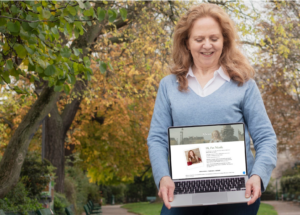In a previous article, I told you there are 2 parts to branding your health coaching business.
One part focuses on making your brand look good. The other part is what gives your brand its value. I call it “the money-making” part.
The money-making part is your positioning. This is the hardest thing for people to do … especially health coaches because you can help a lot of different types of people.
Messaging for Health Coaching Clients
Many health coaches think more types of people give them a bigger pool of potential clients. And while that makes sense in theory, it doesn’t work in practice. You just can’t create strong, client-attracting messaging when you try to talk to a lot of different people.
When it’s done right, your positioning shows your future clients that you’re the best person to help them get the results they want.
The first article took a deep dive into the first of the 3+1 Positioning Principles for health coaches – Person. (There’s a link to it below, in case you missed it.)
Now we need to create messaging that will attract your Person. That’s what the next 2 positioning principles are all about … and what we’ll cover today.
Positioning Principle #2 – Promise
If you want to attract new clients, the first thing you need to do is to get their attention. And the best way to get someone’s attention is to tell them how they’ll benefit from working with you.
That benefit is your brand promise.
It’s essential that you have a brand promise because people make decisions based on how something benefits them.
In fact, everyone has a “benefit filter” that’s constantly working in the background. Most of the time, it’s completely subconscious. Even so, it’s constantly evaluating options. And it “green-lights” an option if it believes you will be better off with it than without it.
For a person whose quality of life is impacted by a health problem, they’re very aware of the benefit they want. In fact, it’s most likely an internal conversation that plays on an endless loop inside their head.
Your brand promise needs to enter that conversation. It needs to sound like it was made for that person.
Now there are a few characteristics of a strong brand promise:
- It identifies the problem you solve
- It’s clear who you solve it for
- It’s specific
- It’s clear and easy to understand
- It overcomes your future client’s objections
- It’s benefit-focused
Your promise should have as many of these characteristics as possible.
When I help health coaches craft their brand promise, we start off by creating a bunch of “I help” statements. For example:
- I help construction workers who struggle with debilitating low back pain get lasting relief naturally
- I help busy women who struggle with brain fog and fatigue so they can have all-day energy and focus … without special diets, taking supplements, or completely overhauling their life
- I help people with type 2 diabetes lower their blood sugar without exercising, pricking their finger every day, or feeling hungry
Then, we turn it into brand messaging that can be adapted for different marketing materials such as their website, business cards, and in their email marketing. For instance …
- Lasting, natural relief for construction workers with debilitating low back pain
- How busy women replace brain fog and fatigue with all-day energy and focus … without special diets, taking supplements, or completely overhauling their life
- Lower your blood sugar naturally without exercising, pricking your finger every day, or feeling hungry and deprived.
Now some health coaches get concerned about making a promise. They’re worried about making a specific health claim in their messaging. And you should never make a claim you can’t back.
But you can give your future clients an idea of the results they can expect. You can let them know what’s possible without over-promising.
For example, you can say, “Lose as much as 8 pounds in the first 2 weeks.” That’s not saying they will lose 8 pounds. But it let’s them know that it’s possible.
Now then. Once you’ve crafted your brand promise, you need to show people how they’ll get results. That’s the job of Positioning Principle #3.
Positioning Principle #3 – Process
Let me tell you a quick story …
My father is half French. He’s in his 90s now, and still in great shape! So for the past few years, we’ve gone to France for a couple of weeks in the summer to visit the family.
Before we go, we pull out the maps and plan our route. Then while we’re in France, Pop spends a lot of time talking to people about what we’ve planned, just in case someone can suggest a better route. But he doesn’t stop there …
When we’re on the road, he has Waze on his phone … he wants me to have the Google navigator on mine … and he has a paper map open so he can follow along.
All of these things make him feel more confident that we’re going to get where we want to go. He can also track the milestones along the way. He likes that.
Well, it’s the same thing with your future clients. When you show them you have a process, it gives them more confidence in you.
Not only that. When they see there’s a process, it gives them hope that they will get results if they follow it.
Your process is your Signature System. It’s how you get your health coaching clients from where they are now … with their problem or pain … to where they want to be. But don’t confuse this with your program. Your Signature System isn’t the same thing as your program. Instead, it’s a marketing message.
The most important thing about a marketing message is that it’s easy to explain, and easy to understand. So you don’t need to spell out every single step you take people through. (Save that for when you’re talking about your program.)
Instead, you want to come up with a 3 to 5-step process. Ideally, each step will be labeled with an outcome.
For example, let’s say you have a process that helps emotional eaters lose weight. Your 3-step process could be:
Step 1: Identify Hidden Triggers
Step 2: Eliminate Food Cravings
Step 3: Restore Nutritional Balance
The best way to come up with your process is to list out all the steps you do and why you do them. Then group them into categories and give the categories a name.
Then once you have your Signature System, you’ll want to include it on your website. You should also talk about it in your content and other types of marketing materials like your emails and ads.
These 2 positioning principles are one of the best ways to attract people who will want to hire you to help them get results!
Now here’s the link I promised you to the first positioning principle. And of course, there’s still one more principle I want to tell you about. It’s the secret to creating a health coaching brand that stands out from the competition … and knocks your business out of the park. That will be the topic of the next post.






